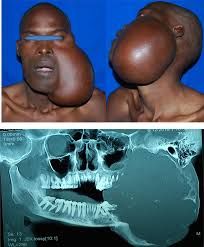"Ameloblastoma is a rare, benign or cancerous tumor of odontogenic epithelium (ameloblasts, or outside portion, of the teeth during development) much more commonly appearing in the lower jaw than the upper jaw. It was recognized in 1827 by Cusack. This type of odontogenic neoplasm was designated as an adamantinoma in 1885 by the French physician Louis-Charles Malassez. It was finally renamed to the modern name ameloblastoma in 1930 by Ivey and Churchill"Source
Although Ameloblastoma as a tumor is rarely malignant or metastatic in its mechanisms of development which means it hardly spread to other parts or regions of the body and progresses slowly in size and cell number, the resulting lesions can cause severe deformities of the orofacial structures leading to severe disfiguration and unesthetic appearance.
Furthermore, as uncoordinated cell growth easily penetrates and breakdown surrounding bony tissues, a prompt and wide surgical excision is needed to curb the spread of this lesion. If an aggressive and abnormally dividing cells are left behind untreated, it can block the nasal and oral airways posing a threat and difficulty in breathing without oropharyngeal intervention and life support aids.
The term "ameloblastoma" is coined from an Old English word amel meaning "enamel" and Greek blastos meaning "germ" meaning together as "enamel germ".
TYPES OF AMELOBLASTOMA
According to WHO in their 2017 classification of Ameloblastoma there are 4 Classes or Types of tumour lesion that were issued in their report which are as follows;
1- Conventional (solid/multicystic) type ameloblastoma
2- Unicystic ameloblastoma
3- Peripheral/extraosseous ameloblastoma
4- Metastasising ameloblastoma
1- Conventional Ameloblastoma
It is one of the most common Ameloblastoma based on the histological appearance and reports and as such it was previously called solid/multicystic ameloblastoma.
It is majorly observed as having multiple and large cystic areas within affected tissues and cells.
2- Unicystic Ameloblastoma
Unicystic means single cyst cavity Ameloblastoma which is usually observed in about 10% cases of ameloblastomas. It is mostly found in younger patients within their second or even third decades of life.
It is usually associated with an unerupted third molar tooth.
3- Metastasising Ameloblastoma
Although Ameloblastoma is regarded as a benign tumour but sometimes some atypical ameloblastoma based on histological tissue arrangement can rarely spread or metastasise to other parts of the body, usually to the lung.
The resulting of the metastasis usually appears histologically identical to the primary tumour that spread and are also benign in nature both in appearance and growth.
4- Peripheral ameloblastoma
The peripheral subtype are extraosseous form of Ameloblastoma cell outgrowth with very little clinical cases as it composes about 2% of all clinically observed ameloblastomas.
That's as regards the introductory aspect of Ameloblastoma. In the subsequent posts we will stretch further on other areas such as histological structure, presentation and therapeutic approach to curb the continuous outgrowth and rarely occuring spread of Ameloblastoma as a common tumour of the lower jaw. Thanks for the usual support.
Happy Blogging and Reading 💥🦷🌴🌴
Video from DentalManiak YouTuber



